Hiking the Quarry trail to Machu Picchu – the story of our 3-day hiking adventure in the beautiful Andes, via the alternative route to Machu Picchu

When it comes to visiting Machu Picchu, you really have two basic options: if you’re a more adventurous traveler, you can embark on a 3-day hike along the famous Inca trail which ends at Machu Picchu on the forth morning, or alternatively, you can catch a train from Ollantaytambo to Agua Calientes, and then take the 20-minute bus ride to the site.
There’s never been a doubt in our mind that we would pick the trekking option. In fact, this whole hiking to Machu Picchu idea was the single most attractive reason for us to go. However, since we booked our trip very last minute, and did not do our research, we realized that there weren’t spaces left for the Inca trail. Being one of the world’s most famous hikes, the Inca trail requires a permit, and a licensed tour guide, and there are a limited number of permits given out per year. These obviously sell out quickly, so you need to book them at least 6 months in advance, if you wish to walk in the steps of the ancient Incas, and trek all 45 km of the Inca trail.
Well, it turned out there is a third option to go to Machu Picchu – take an alternative hike via the Inca Quarry trail. You still get to hike, and camp in the Andes, and enjoy the breathtaking views, but you won’t get to Machu Picchu by entering through the famous Sun Gate. In other words, you don’t hike to Machu Picchu, you hike around Machu Picchu, then take the train and bus to get there. We thought that was an acceptable compromise, and enrolled for the Inca Quarry trail hike via Intrepid.
The Inca Quarry trail starts and ends near Ollantaytambo, and during the course of 2.5 days, you hike 26 km, and reach elevation of 4,450 meters above sea level. It wasn’t the Inca trail, but it still was an unforgettable experience.
Day 1: hiking

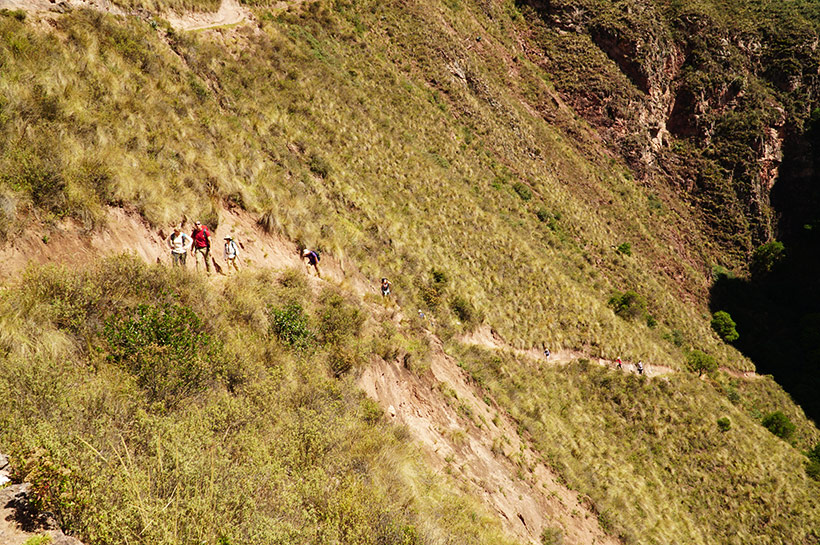
We got up at 5 am, had a quick breakfast, and jumped on a bus, that took us to the trail head. We met our horsemen there, who were going to be our porters, cleaners, cooks, helpers, and overall life savers for the next 3 days. They piled our duffel bags on the horses, and hurried up ahead of us.
By 7:30 am we were on the trail. It was freezing, and we layered up everything we’ve brought in our daypacks. The hike started easy, and soon after, we passed by a small mountain community called Socma, where we visited the local school, and met the kids. There were just a handful of them, varying in age. Some of the kids would trek in the mountains for 2 hours every day to get to school.


From then on, the climb got steadily steeper. The layers of clothes came off quickly, as our pace picked up. It had been raining the days before but we were lucky to have clear blue skies, and sunny weather that day, and for the rest of our hike. We reached our second stop – the beautiful Perolniyoc waterfall and overlook an hour later. It was a great spot for a short snack break, with sprawling views of the valley below.

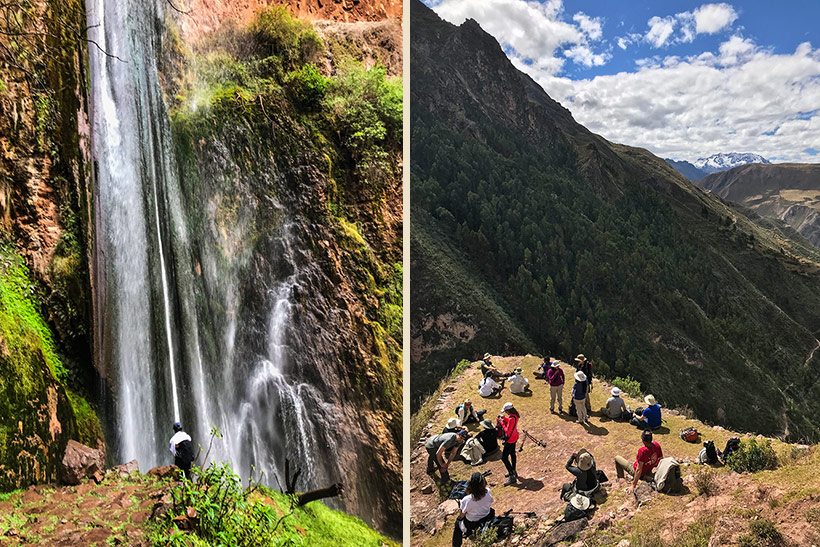

We continued up for another hour or so, until we arrived at the Q’orimarca ruins shortly after noon. While we were taking our time to explore, relax, and just take in the views, our porters setup camp, not far from the ruins. By the time we got there, our tents were up, and our lunch was waiting for us. We had quinoa vegetable soup, and stuffed chicken breast with spinach and cheese, veggies and rice on the side! Quite impressive for a camp lunch!





We were done with hiking for the day, and we had the remaining afternoon to ourselves. Around 4 pm we all got together in the big dining tent, for a snack of popcorn, and hot chocolate. We definitely needed something warm by then, as it was getting quite chilly. Our chef even managed to prepare, and decorate a birthday cake for one of the guys in the group! We were blown away!
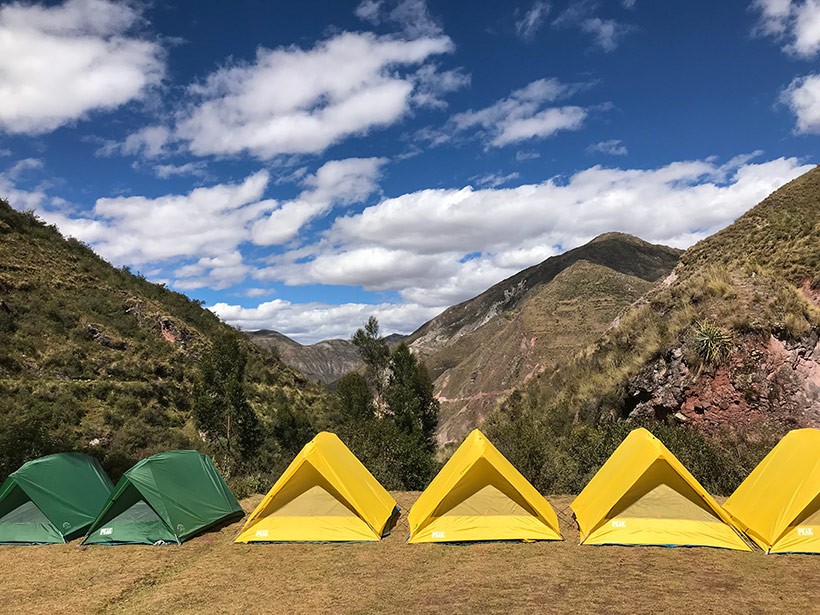
1st campsite

It’s amazing what the chef could whip up in a tent!
Our first camp dinner was a three-course gourmet treat. We started with a soup, then baked trout with veggies and rice for main course, and for dessert we had flambeed bananas in chocolate sauce! I certainly did not expect that level of gourmet on camp.
Day 2: hiking

Day two started bright and early, at 5:30am. The porters woke us up with a cup of steaming coca leaf tea – a life saver, after a bone-chilling night, which helped us thaw our stiff bodies a bit. We knew we had a tough day ahead of us – the longest hike – 10km, mostly uphill, at high altitude, so we had to dress up, pack up, and eat quickly.

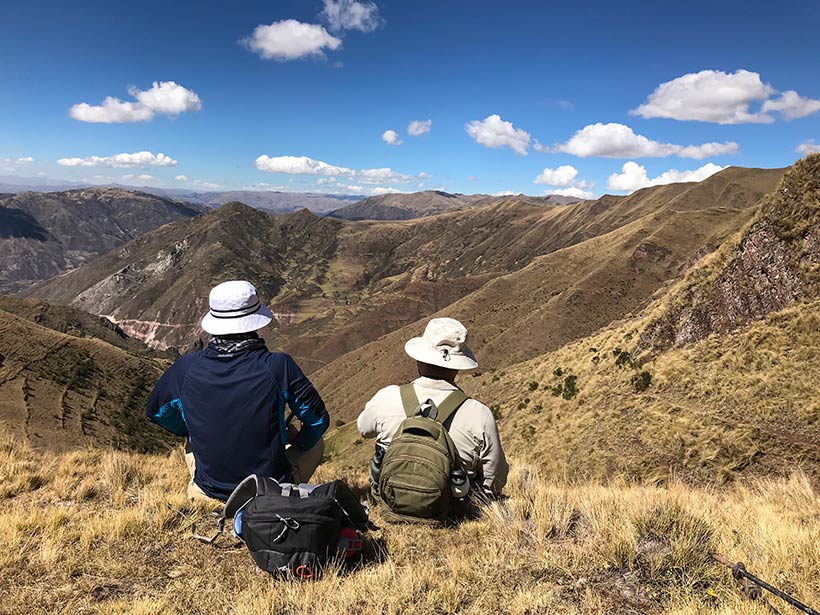
For the first 4-5 hours, the trail was steep and not very memorable. We were advancing up the hill at a slow pace, as we began to feel the lack of oxygen in the air, and to our surprise had to stop every 15-20 minutes to catch our breath. Every time we climbed over a hill, there was another to conquer in the distance. And every time, we felt a small victory, and pushed on with masochistic resolve. It was around noon when we climbed up to the top of the last visible hill, and without any warning, our sight exploded with the grand vista in front – majestic snow-capped Veronica mountain opened up and revealed the valley below.



This vista point was probably the highlight of the whole hike, as it was so unexpected and stunningly beautiful. From then on, the views kept rolling, and we kept walking quite enthusiastically. It was the best part of the trek, with almost no incline, and beautiful views all around for the next 3 hours or so.


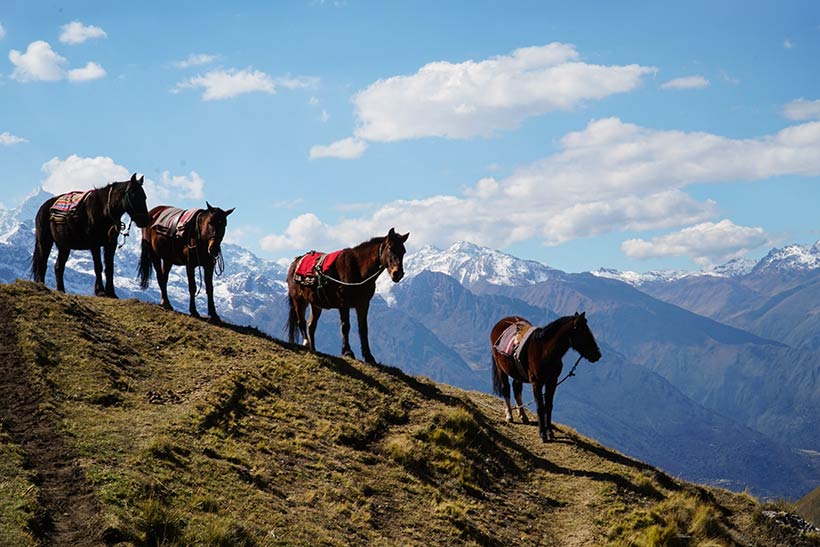
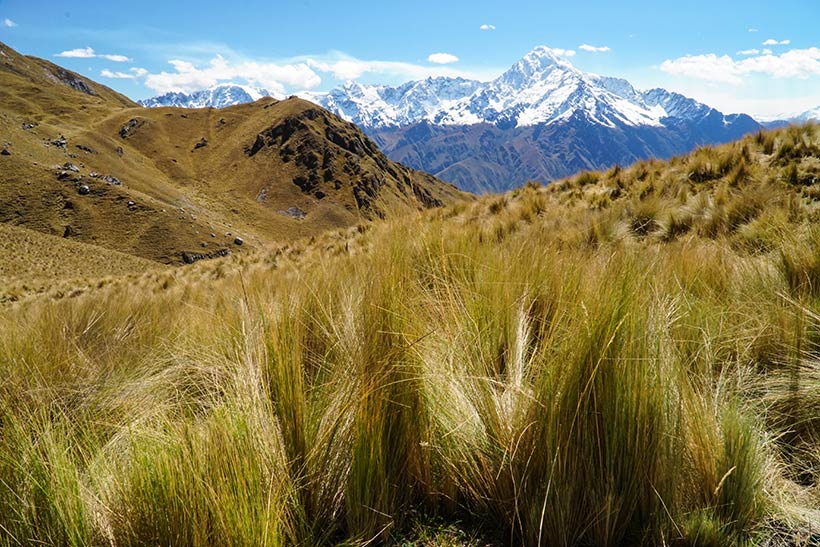

We only stopped for a quick lunch to get some much needed rest, and refill our water bottles, and hurried up to the highest elevation point, sitting at 4,450 m above sea level.

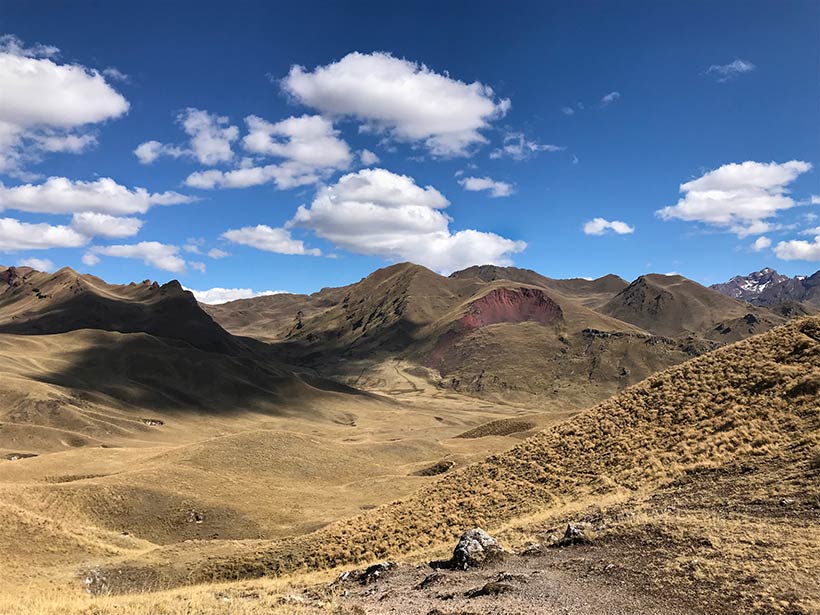




After that, the hike started winding downhill, and believe it or nor, this part was actually harder. The path was rocky, and slippery, and it’s a good thing we decided to rent a hiking pole. The final stretch of the hike ended at the Inti Punku (Sun Gate), perched on top of a hill, overlooking the snow-capped mountains. We barely made it in time for the sunset, and managed to steal a few good photos, before heading to camp in the dark.

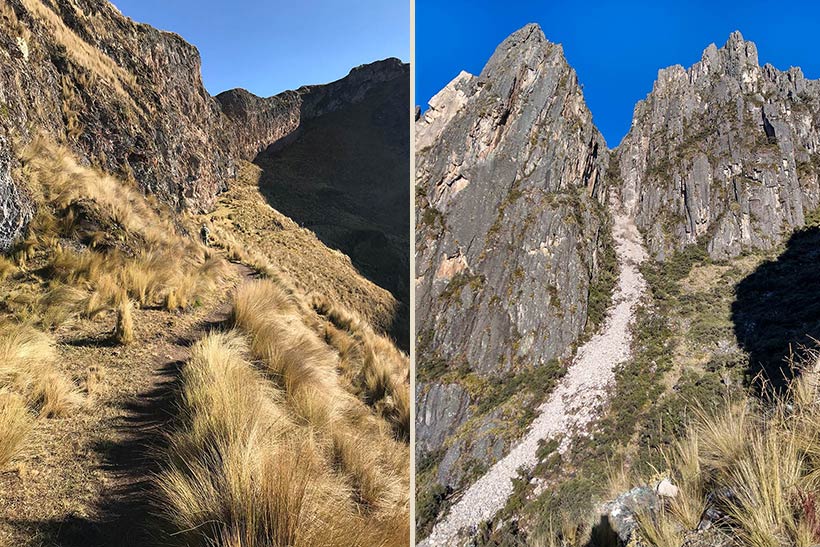




That night we were so exhausted we scrambled to bed almost right after dinner. Our chef made fish with vegetables and rice, and for desert we had flan! Not sure how he pulled that one off!
Day 3: hiking & Agua Calientes


We woke up at sun rise, and as we opened the tent, we were surprised to see our tent was perched on the edge of a steep slope! As we made our way into camp in the dark, the day before, we had no idea of our surroundings. That morning, we had our last breakfast outside, basking in the early morning sun rays. After exchanging thank you-s and pictures with our porters, we said our good-buys to them, and started on the last stretch of our hike.


Our last day of hiking was all downhill, until we reached the town of Ollantaytambo. On the way, we passed by the Inca Quarry, which was used to carve out the stones for the Ollantaytambo ruins. It’s a small wonder how the Incas, who did not have knowledge or use of the wheel at the time, were able to transport 3-ton heavy stone blocks from the quarry in the mountains all the way down to the town, and cut the stones so precisely that they would fit together without the need to use mortar…
We made it to town by noon, and almost immediately caught the train to Agua Calientes, a.k.a. Machu Picchu town. The train ride was pretty good, complete with lunch, and snacks, and gorgeous views.

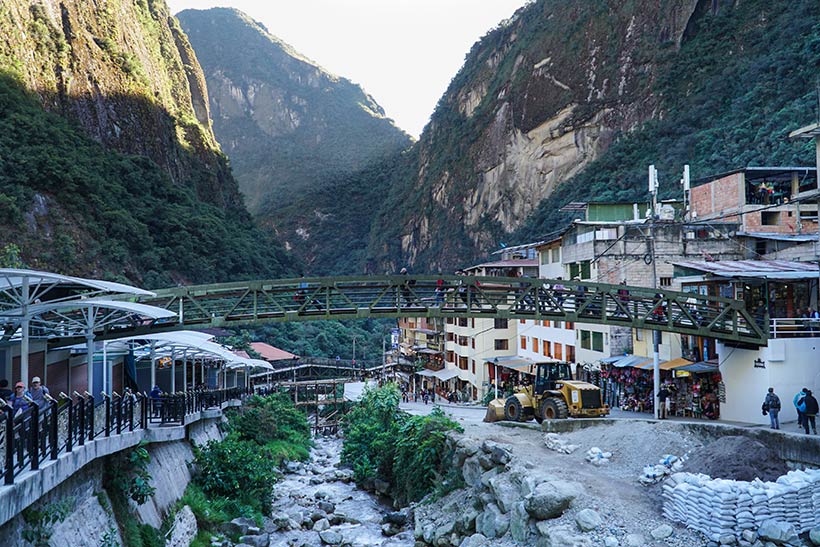
We arrived at Agua Calientes in the late afternoon, and had time to shower (finally!), and walk around town. Agua Calientes hosts millions of tourists every year, and understandably it feels very touristy. It’s a small town, with a train track running in the middle, and a few shops, and restaurants, offering mostly American or Chinese food options. Two things caught my eye at every corner – a sign for a massage, and a sign for laundry – both necessities after a few days of hiking 🙂 They also have natural hot springs in town (hence the name ‘Agua Calientes’, or ‘hot water’), but honestly we did not feel like making the effort to find them given the short amount of time. We just wanted to relax and maybe have a well deserved pisco sour.
The hotel bed that night felt incredibly comfy and soft, which made it all the more difficult to leave at 4 am the next day.
Day 4: Machu Picchu

After 3 days of gorgeous Andean views, we were ready and excited for the grand finale – Machu Picchu. Since our visit was part of Intrepid’s organized tour, there were time limitations, so we were determined to maximize our stay as best as we could. We knew we wanted to catch the first bus to get there in time for the sunrise, and we knew the first bus leaves at 5:30 am. After much debate and hearing different opinions about the best time to get in line for the bus, we finally settled on 4:00 am.
It was 4:15 am when we left our hotel, and made our way to the bus stop. At every corner, there were people hurrying in the same direction. As we approached the bus stop, the line was thick, and growing by the second, winding up the street with no end. It was clear that we wouldn’t get on the first bus, and we assumed we would probably miss the sunrise. All the cafes and restaurants along the street were open, and offering hot drinks, breakfast, and souvenirs, should you need any, in the middle of the night. We took our spot resigned, and patiently waited for the next 1.5 hours in the cold and dark, alternating between drinking hot coffee, and nibbling on some snacks to keep awake and warm.
The buses arrived at 5:30 sharp, and we managed to get on the forth bus in line. They all left immediately, and after a 25-minute ride along the winding, steep road, we arrived at the park just before it opened at 6 am. Phew! We made it!!
We hurried up the steep path that starts at the entrance, and 10 minutes later, breathless and excited, finally saw it – jaw-dropping and majestic, the sight of Machu Picchu was so much more than we’ve imagined it to be. There was something inexplicably mythical and other-worldly about this place, and all we could do was stare in awe. It wouldn’t be another 2 hours before the sun finally rose above the mountain, and lit up the whole area, and it was then, we saw it in its full glory.
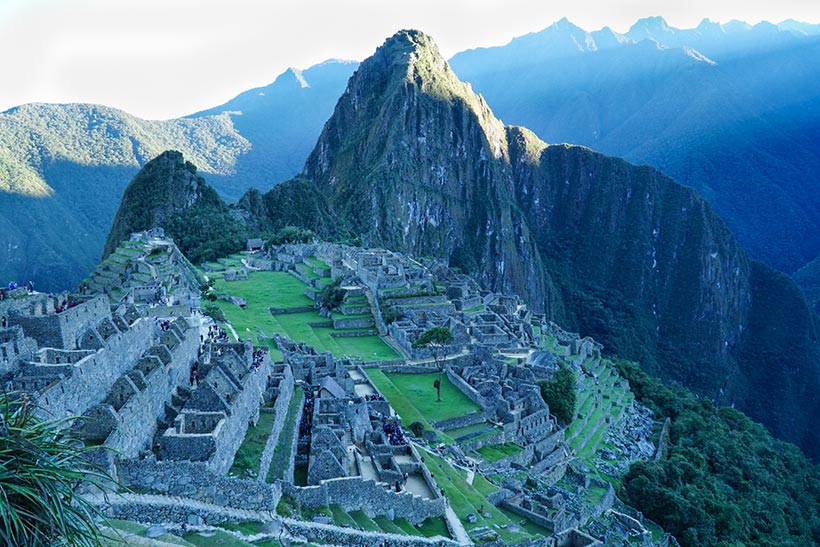
Machu Picchu at sunrise
Machu Picchu, stands 2,430 m tall, amid a tropical mountain rainforest. The name Machu Picchu means ‘old peak’. However, a more accurate translation would be ‘big peak, to differentiate from Huayna picchu, or ‘small peak’ which is the name of the iconic rock that towers just above the ruins. Erroneously dubbed as ‘the lost city of the Incas’ by Hiram Bingham, who found the site in 1911, the place remains shrouded in mystery ever since. There are no written documents to explain what Machu Picchu was, or what purpose it served, as the Incan empire, despite its advanced skills in architecture, construction and agriculture, did not have a system of writing. No wonder that the enigma of Machu Picchu remains as strong today as ever, constantly fed by myth and fiction to explain the unknown.


Based on its dramatic setting, and isolated location, the site is presumed to have been a luxury retreat for Inca rulers, a citadel, or a ceremonial site. There are about 200 structures on the premise, and it’s clearly divided into a residential area, and a ceremonial area, split by an open space. There are over 700 agricultural terraces surrounding the structures, that are believed to have sustained a population of about 750 people who lived there, most of whom were servants of the elites. The site was built in the late 15th century, around the time of the famous Inca ruler Pachacuti, but was abandoned a century later, about the time when the Inca empire fell to the Spanish conquistadors. The Spaniards never found the site, it seems from its well-preserved shape, and over the next 400 years, the jungle ‘swallowed’ the ruins, and hid them from view. When the American explorer Hiram Bingham came to visit, he found three local families who lived and farmed the land on the site.
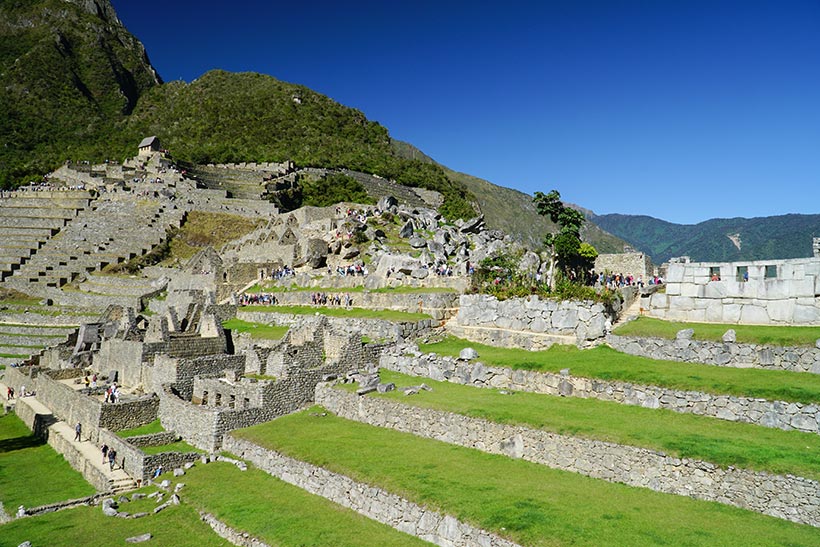




We were lucky to have one of the clearest days, with no clouds at all cluttering the view (this was apparently was quite rare, according to local guides). We didn’t take our luck for granted. The next few hours flew by – after a guided tour of the ruins, we mostly roamed around, and admired the view,. The site was packed with tourists but somehow it absorbed the crowd gracefully, and it didn’t feel that bad. We couldn’t do the 45-minute hike to Inti Punku (the Sun Gate), or visit the hanging bridge, or hike to the top of Huayna peak, and for once, I felt at peace for missing out. I wanted to take it easy, just be there, and enjoy the magic of the moment.
That day, we returned to Cusco, for our last night there, before we embarked on our final Peruvian adventure – the Amazon jungle! More on that, in my next post.
A few useful things to keep in mind when hiking the Andes:
- A pair of good quality, comfy hiking shoes is a must. I highly recommend Merrell brand. Get them one size bigger, and waterproof if possible, and make sure you do some hiking before the trip, to break them in.
- Sturdy, medium thick, moisture wicking hiking socks, and a pair of slides to walk about camp.
- Bring lots of layers – it gets really cold at night, and quite hot during the day. Scarves, hats, gloves, and warm leggings are a must.
- Bring lots of sunscreen for both your body and lips.
- Wear a hiking hat with wide brim, and adjustable drawcord.
- Bring a poncho, in case it rains.
- Bring a water bottle with a 2-liter capacity. Don’t worry about the water – the porters will provide clean water at all times.
- Bring some altitude sickness pills, and start taking them before you get to Cusco so your body can more easily acclimate. Although I did not get mountain sickness, I got headaches which could’ve been the result of both high altitude and mild dehydration, so pack some Advil or other pain killer too.
- You will hear this advise multiple times – drink lots of water, and stay hydrated at all times, to prevent or alleviate mountain sickness symptoms.
- No need to bring snacks – they are provided by the guides.
- It’s best to rent a hiking pole (at least one). We rented one pair and each of us got one pole. It helps especially going downhill.
- Sleeping bags are provided, but pillows aren’t, so bring portable, inflatable pillows – they can easily fit in your backpack, and aren’t heavy.
If you have any questions about any portion of this trip, don’t hesitate to leave a comment!